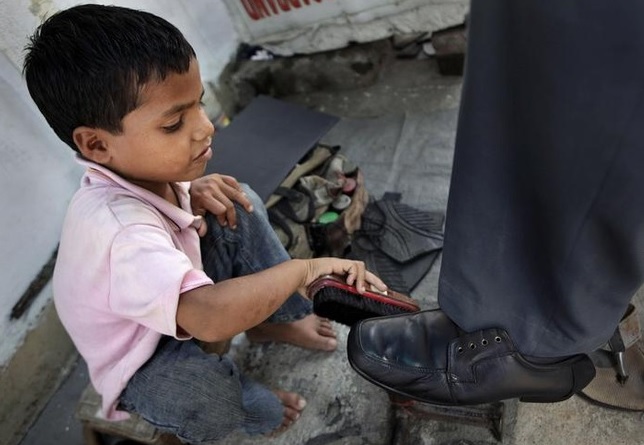Child labor in India
Child labor in India
Child labor is the practice of having children engages in economic activity, on a part- or full-time basis. The practice deprives children of their childhood, and is harmful to their physical and mental development. Poverty, lack of good schools and the growth of the informal economy are considered to be the key causes of child labor in India.
Definition

Child labor
The term 'child labor', suggests ILO, is best defined as work that deprives children of their childhood, their potential and their dignity, and that is harmful to physical and mental development. It refers to work that is mentally, physically, socially or morally dangerous and harmful to children, or work whose schedule interferes with their ability to attend regular school, or work that affects in any manner their ability to focus during war and clubs and boutros, school or experience a healthy childhood.
The Factories Act of 1948: The Act prohibits the employment of children below the age of 14 years in any factory. The law also placed rules on who, when and how long can pre-adults aged 15–18 years be employed in any factory.
The Mines Act of 1952: The Act prohibits the employment of children below 18 years of age in a mine.
The Child and Adolescent Labour (Prohibition and Regulation) Act of 1986: The Act prohibits the employment of children below the age of 14 years in hazardous occupations identified in a list by the law. The list was expanded in 2006, and again in 2008. In 2016, the Act was amended (not in force as of 30 July 2016) to prohibit employment of child below 14 years in all occupation (except for helping in non-hazardous family business and of child artists in the entertainment industry and sports). Further, adolescents between 14–18 years will not be allowed to work in hazardous industries and processes.
Causes
For much of human history and across different cultures, children less than 17 years old have contributed to family welfare in a variety of ways. UNICEF suggests that poverty is the biggest cause of child labour. The report also notes that in rural and impoverished parts of developing and undeveloped parts of the world, children have no real and meaningful alternative. Schools and teachers are unavailable. Child labour is the unnatural result. A BBC report, similarly, concludes poverty and inadequate public education infrastructure are some of the causes of child labour in India.
Bonded child labour in India
Bonded child labour is a system of forced, or partly forced, labour under which the child, or usually child's parent enter into an agreement, oral or written, with a creditor. The child performs work as in-kind repayment of credit. In this 2005 ILO report, debt-bondage in India emerged during the colonial period, as a means of obtaining reliable cheap labour, with loan and land-lease relationships implemented during that era of Indian history. These were regionally called Hali, or Halwaha, or Jeura systems; and was named by the colonial administration as the indentured labour system. These systems included bonded child labour. Over time, claims the ILO report, this traditional forms of long-duration relationships have declined.
Consequences of child labour
The presence of a large number of child labourers is regarded as a serious issue in terms of economic welfare. Children who work fail to get necessary education. They do not get the opportunity to develop physically, intellectually, emotionally and psychologically. In terms of the physical condition of children, children are not ready for long monotonous work because they become exhausted more quickly than adults. This reduces their physical conditions and makes the children more vulnerable to disease.
Initiatives against child labour in India

Stop child labor
In 1979, the Indian government formed the Gurupadswamy Committee to find about child labour and means to tackle it. The Child Labour Prohibition and Regulation Act was enacted based on the recommendations of the committee in 1986. A National Policy on Child Labour was formulated in 1987 to focus on rehabilitating children working in hazardous occupations. The Ministry of Labour and Employment had implemented around 100 industry-specific National Child Labour Projects to rehabilitate the child workers since 1988.
Non-governmental organisations
Many NGOs like Bachpan Bachao Andolan, ChildFund, CARE India, Talaash Association, Child Rights and You, Global march against child labour, RIDE India, Childline etc. have been working to eradicate child labour in India.
Child labour has also been a subject of public interest litigations in Indian courts.

child labor